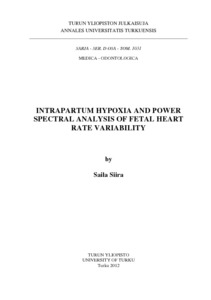Intrapartum hypoxia and power spectral analysis of fetal heart rate variability
Siira, Saila (2012-10-05)
Intrapartum hypoxia and power spectral analysis of fetal heart rate variability
Siira, Saila
(05.10.2012)
Annales Universitatis Turkuensis D 1031 Turun yliopisto
Julkaisun pysyvä osoite on:
https://urn.fi/URN:ISBN:978-951-29-5124-6
https://urn.fi/URN:ISBN:978-951-29-5124-6
Kuvaus
Siirretty Doriasta
ei tietoa saavutettavuudesta
ei tietoa saavutettavuudesta
Tiivistelmä
Reliable detection of intrapartum fetal acidosis is crucial for preventing morbidity.
Hypoxia-related changes of fetal heart rate variability (FHRV) are controlled by the
autonomic nervous system. Subtle changes in FHRV that cannot be identified by
inspection can be detected and quantified by power spectral analysis. Sympathetic
activity relates to low-frequency FHRV and parasympathetic activity to both low- and
high-frequency FHRV.
The aim was to study whether intra partum fetal acidosis can be detected by
analyzing spectral powers of FHRV, and whether spectral powers associate with
hypoxia-induced changes in the fetal electrocardiogram and with the pH of fetal blood
samples taken intrapartum. The FHRV of 817 R-R interval recordings, collected as a
part of European multicenter studies, were analyzed. Acidosis was defined as cord pH ≤
7.05 or scalp pH ≤ 7.20, and metabolic acidosis as cord pH ≤ 7.05 and base deficit ≥ 12
mmol/l.
Intrapartum hypoxia increased the spectral powers of FHRV. As fetal acidosis
deepened, FHRV decreased: fetuses with significant birth acidosis had, after an initial
increase, a drop in spectral powers near delivery, suggesting a breakdown of fetal
compensation. Furthermore, a change in excess of 30% of the low-to-high frequency
ratio of FHRV was associated with fetal metabolic acidosis.
The results suggest that a decrease in the spectral powers of FHRV signals concern
for fetal wellbeing. A single measure alone cannot be used to reveal fetal hypoxia since
the spectral powers vary widely intra-individually. With technical developments,
continuous assessment of intra-individual changes in spectral powers of FHRV might
aid in the detection of fetal compromise due to hypoxia.
Hypoxia-related changes of fetal heart rate variability (FHRV) are controlled by the
autonomic nervous system. Subtle changes in FHRV that cannot be identified by
inspection can be detected and quantified by power spectral analysis. Sympathetic
activity relates to low-frequency FHRV and parasympathetic activity to both low- and
high-frequency FHRV.
The aim was to study whether intra partum fetal acidosis can be detected by
analyzing spectral powers of FHRV, and whether spectral powers associate with
hypoxia-induced changes in the fetal electrocardiogram and with the pH of fetal blood
samples taken intrapartum. The FHRV of 817 R-R interval recordings, collected as a
part of European multicenter studies, were analyzed. Acidosis was defined as cord pH ≤
7.05 or scalp pH ≤ 7.20, and metabolic acidosis as cord pH ≤ 7.05 and base deficit ≥ 12
mmol/l.
Intrapartum hypoxia increased the spectral powers of FHRV. As fetal acidosis
deepened, FHRV decreased: fetuses with significant birth acidosis had, after an initial
increase, a drop in spectral powers near delivery, suggesting a breakdown of fetal
compensation. Furthermore, a change in excess of 30% of the low-to-high frequency
ratio of FHRV was associated with fetal metabolic acidosis.
The results suggest that a decrease in the spectral powers of FHRV signals concern
for fetal wellbeing. A single measure alone cannot be used to reveal fetal hypoxia since
the spectral powers vary widely intra-individually. With technical developments,
continuous assessment of intra-individual changes in spectral powers of FHRV might
aid in the detection of fetal compromise due to hypoxia.
Kokoelmat
- Väitöskirjat [2963]
